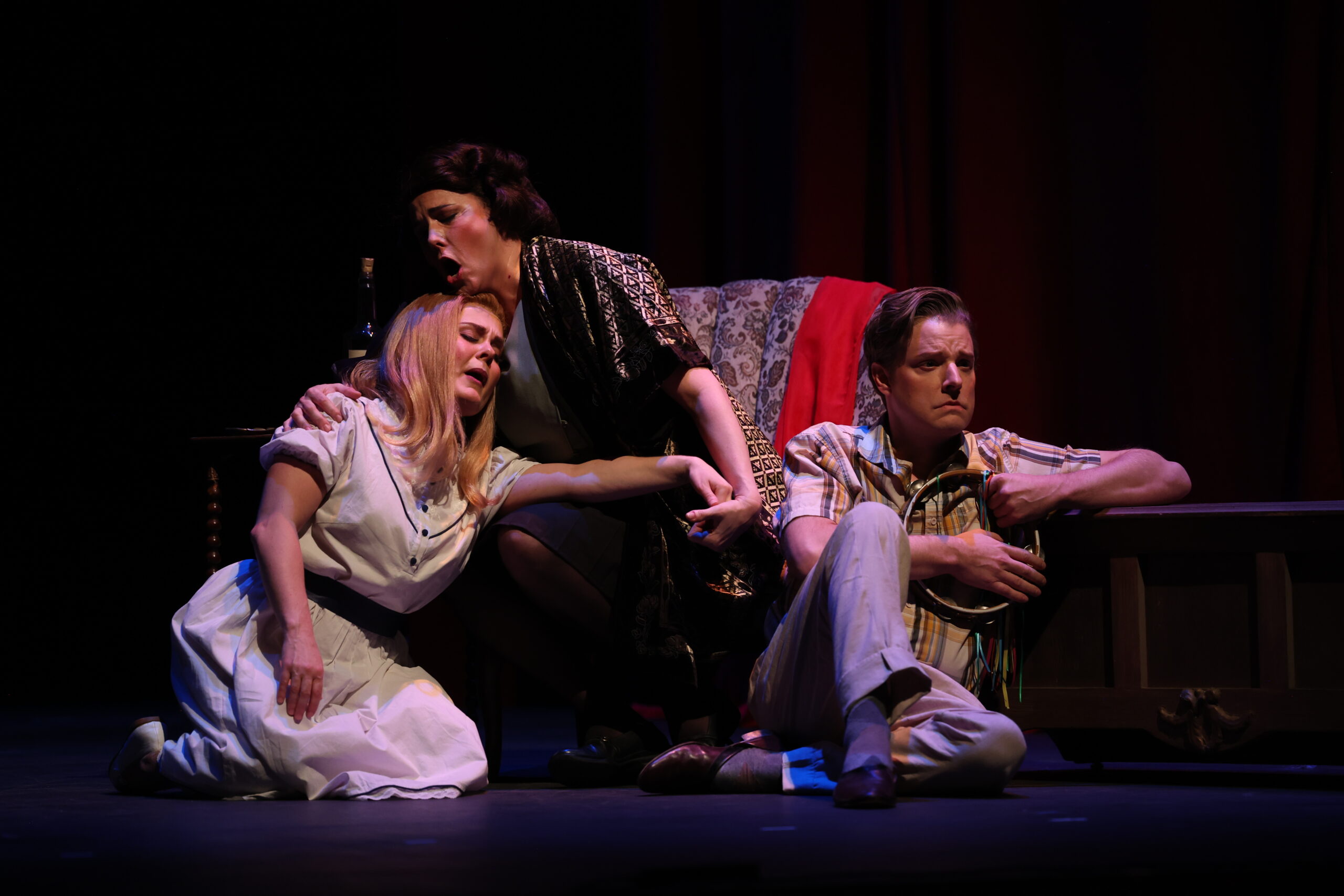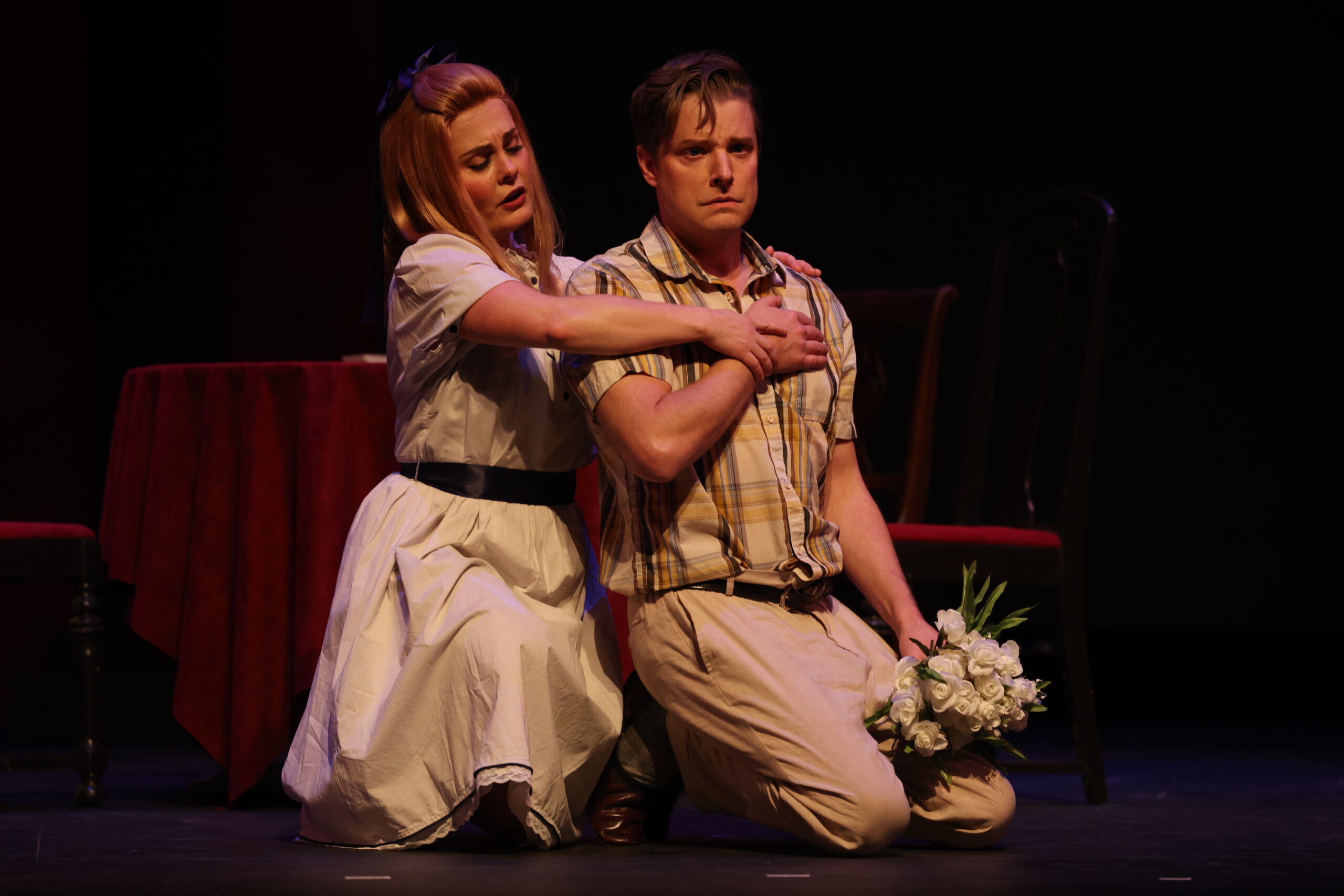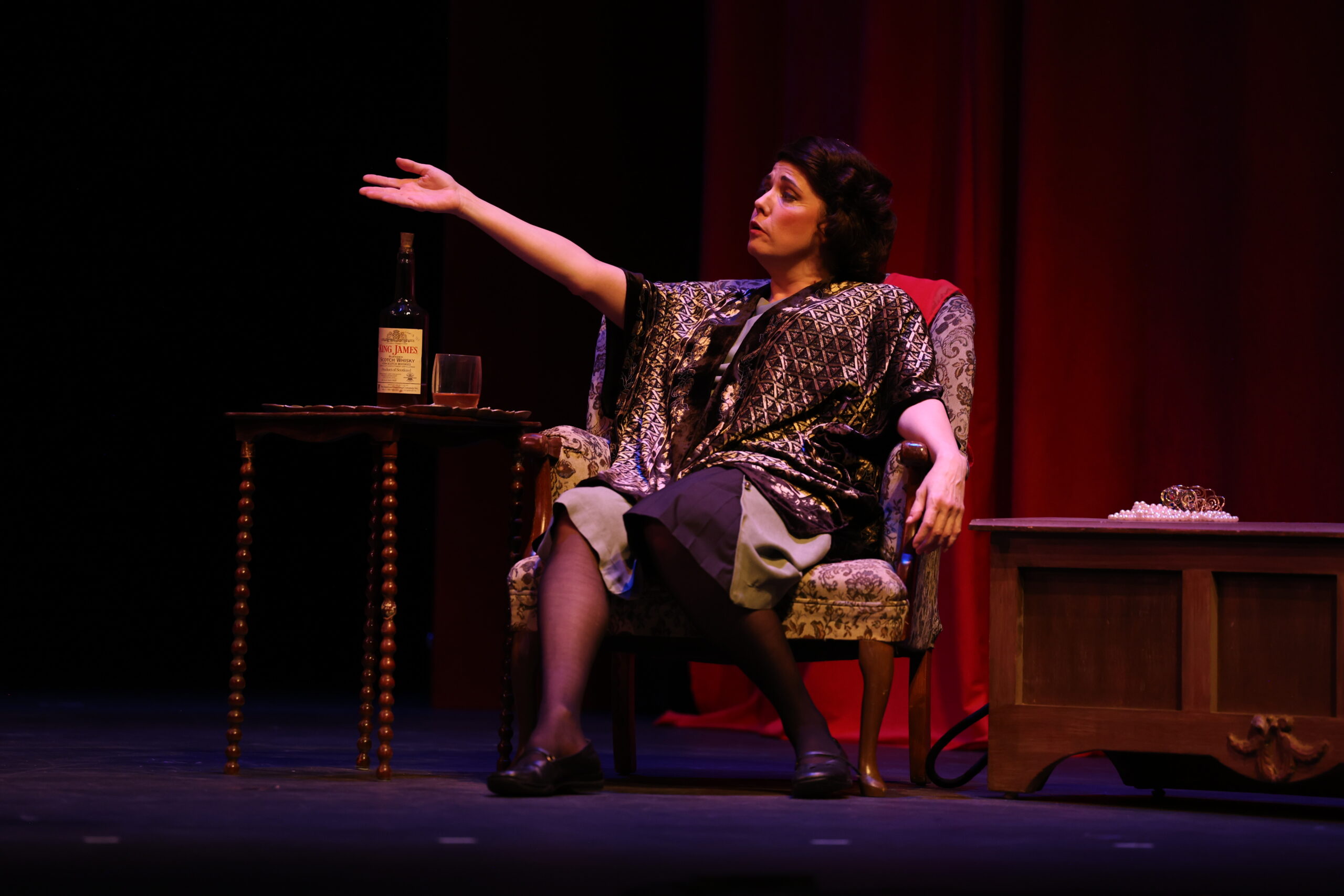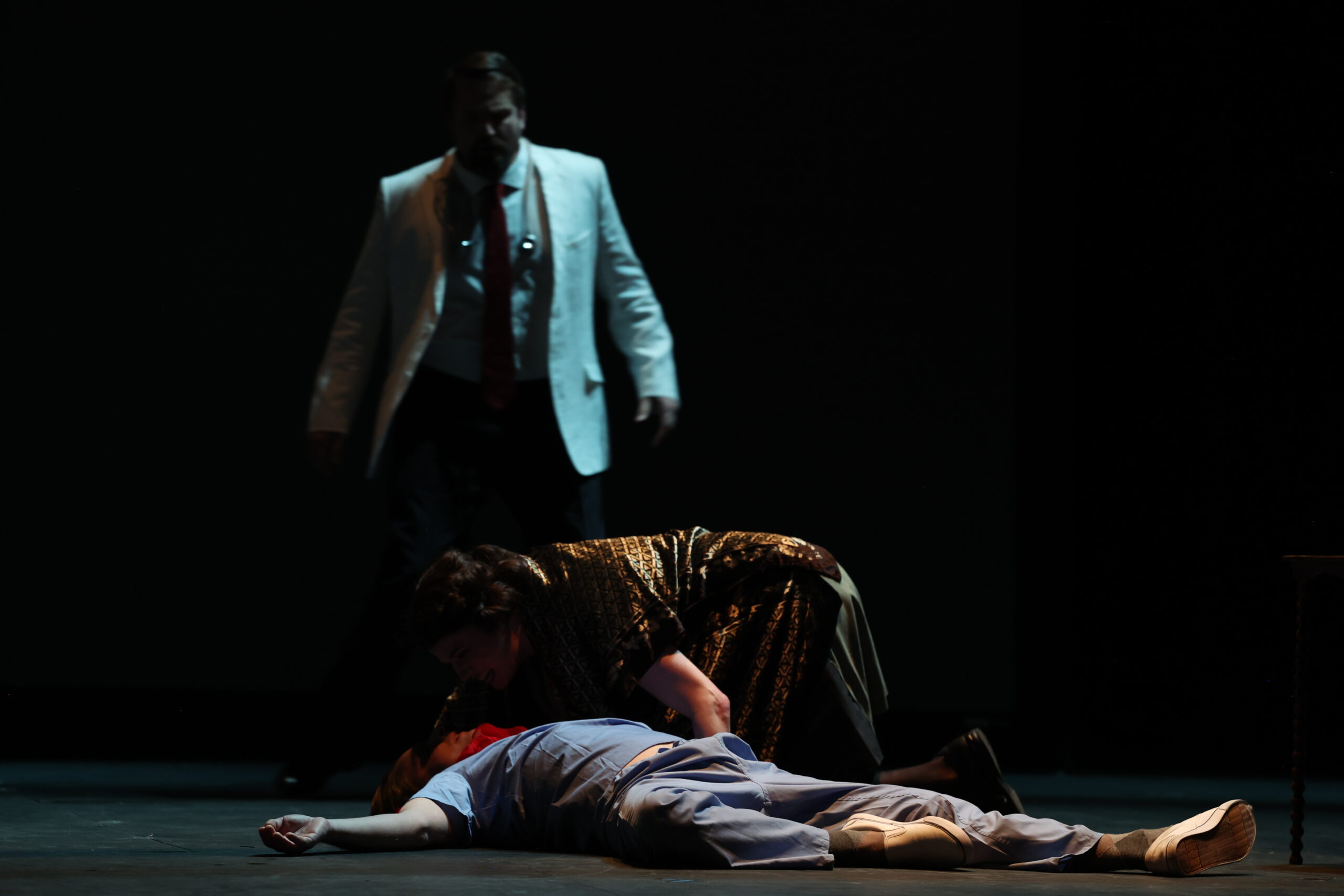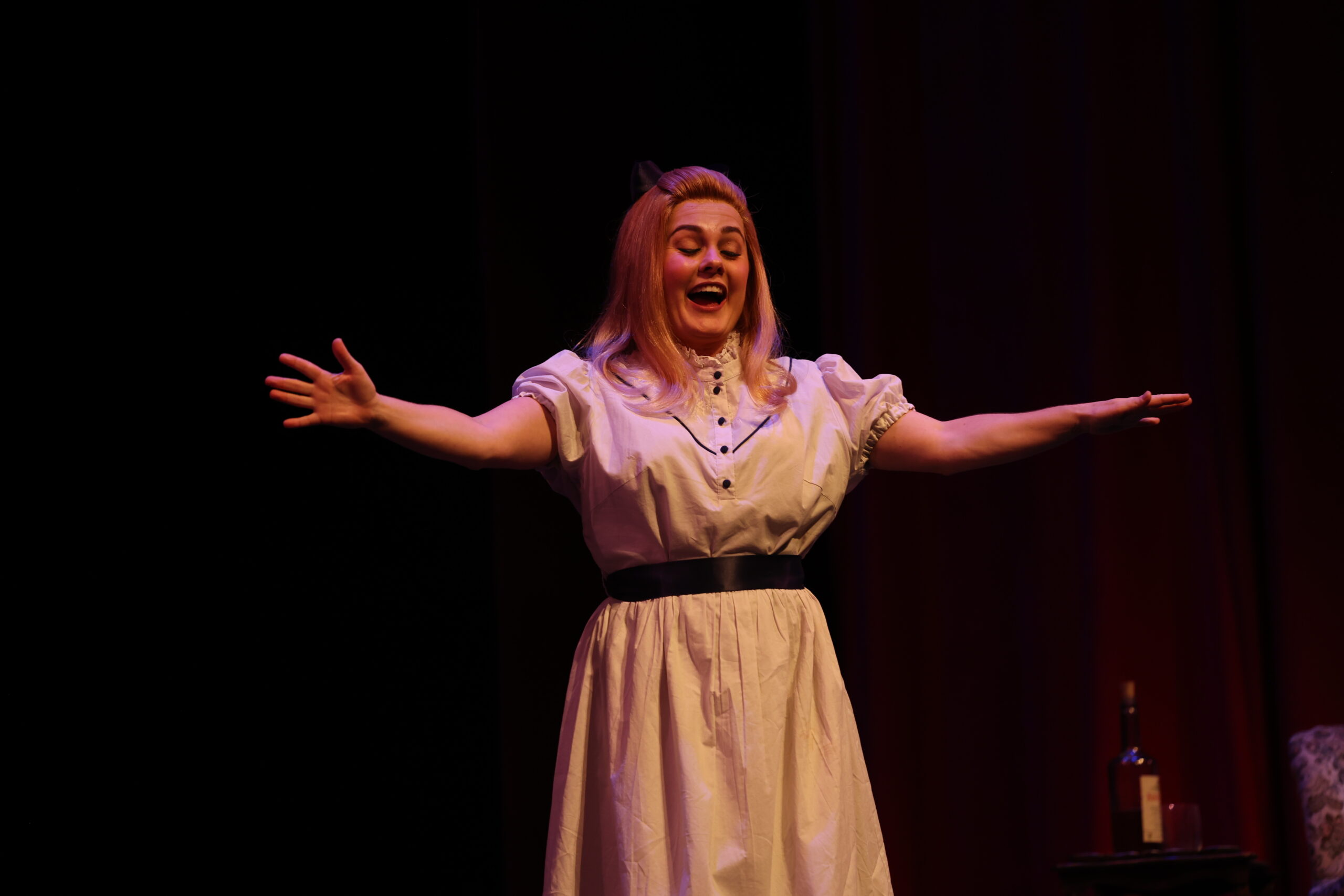Anchorage Opera opened its 2025–26 season with a bold and unforgettable choice: Gian Carlo Menotti’s The Medium, performed November 7, 9, and 10 at the Discovery Theatre inside the Alaska Center for the Performing Arts. This haunting compact opera, first premiered in 1946, is an intense psychological drama that explores guilt, faith, and the dangerous edges of belief. In this production, under the baton of Maestro Christopher Zemliauskas and the creative direction of Anchorage Opera General Director Ben Robinson, Anchorage Opera delivered a work that was both intimate and electrifying. It was a perfectly executed blend of theatricality and truth that left the audience breathless.
Set in post–World War II Budapest, The Medium tells the story of Madame Flora, known as Baba, a fraudulent spirit medium who earns her living conducting fake séances. She is assisted by her daughter, Monica, and a mute servant, Toby, who help her create the illusion of communication with the dead. The opera begins in deceit and ends in despair: during one of her staged séances, Baba feels an unseen hand make contact with her. Whether this touch is real, imagined, or a projection of guilt is never made clear, but it shatters her already fragile control. Her descent into paranoia and violence, perhaps exacerbated by intoxicating liquor and ultimately culminating in tragedy, forms the emotional and dramatic spine of the piece.
Alissa Anderson, as Baba, delivered a performance of astonishing depth and raw emotional power. From her first entrance, Anderson commanded attention with an imposing physical presence and a voice that could pivot from rich authority to desperate fragility in an instant. Her portrayal captured Baba’s psychological disintegration with terrifying realism, never lapsing into caricature. By the final scene, when Baba’s guilt and fear consume her entirely, Anderson had transformed the role into a portrait of a woman haunted not by ghosts, but by her own conscience. It was a performance that anchored the entire production and lingered in memory long after the curtain fell.
Performing the role of Monica, Ashley Emerson provided the perfect foil to Anderson’s turbulent energy. Her voice, notably warm, crystalline, and flexible, illuminated Menotti’s most lyrical passages, especially in the tender “Monica’s Waltz” and the haunting lullaby “The Black Swan.” Emerson’s performance radiated innocence and compassion, her pure tone and expressive phrasing offering moments of repose amid the surrounding chaos. Her relationship with Toby was especially poignant: the two characters’ connection, built on gestures and unspoken affection, provided the opera’s emotional center.
Ben Robinson, who not only directed the production but also portrayed Toby, gave an astonishingly moving and understated performance. As the mute servant, Robinson communicated volumes through movement, posture, and gaze. His silence became its own kind of music, a constant reminder of the opera’s central tragedy: the human cost of misunderstanding. His dual role as performer and director was seamlessly integrated; his attention to physical detail and emotional rhythm brought coherence and precision to every moment on stage.
The supporting cast added texture and nuance to the drama. Justin Birchell and Meghann Welsh as Mr. and Mrs. Gobineau imbued their roles with a blend of naïve hope and comic realism, making their séance scenes feel eerily believable. Nancy Caudill’s Mrs. Nolan was a picture of grief and longing, her brief appearance highlighting the genuine pain that Baba’s false séances exploit. Together, the ensemble lent the production both humanity and emotional contrast as the ordinary world pressed up against the supernatural one.
Musically, The Medium is one of Menotti’s most sophisticated works, walking a fine line between lyrical beauty and jagged dissonance. Under Maestro Christopher Zemliauskas’s baton, the orchestra captured this balance perfectly. The ensemble was powerful, every instrument contributing to the opera’s claustrophobic tension. Zemliauskas drew out the music’s psychological layers: the tender melodies of Monica’s songs, the eerie stillness of the séance scenes, and the explosive bursts of Baba’s rage, all executed with sensitivity and control. The pacing was tight, allowing the score’s rhythmic urgency to drive the story inexorably toward its tragic end.
Visually, the production was a triumph. Scenic Designer Lauren MacKenzie Miller created an intimate, richly textured environment that mirrored the opera’s emotional landscape. Her set, a cramped, dimly lit parlor cluttered with séance props and half-broken relics, seemed to close in on the characters as Baba’s sanity unraveled. Lighting Designer Cedar Cussins heightened the sense of dread with bold contrasts of shadow and illumination, using sudden flashes and subtle color shifts to evoke both psychological and supernatural states. The lighting design, especially in the opera’s final moments, created an atmosphere of dreamlike uncertainty that made the audience question what was real and what was imagined.
Costume Coordinator Kathryn Braden and Hair and Makeup Designer Elle Janecek added visual cohesion and authenticity, grounding the characters firmly in the postwar period while also reflecting their emotional states. Baba’s increasingly disheveled appearance mirrored her unraveling mind, while Monica’s soft, delicate look underscored her innocence and vulnerability.
One of the production’s most striking features was Robinson’s integration of cinematic elements into the opera’s finale. The use of film projections subtly interlaced with live performance created a powerful sense of blurred reality. It was as if Baba’s visions had spilled beyond the stage into another dimension. This inventive touch added layers of ambiguity to the ending, leaving the audience suspended between the supernatural and the psychological. It was a bold directorial choice that elevated the production from excellent to unforgettable.
Behind the scenes, Production Stage Manager Helen Irene Pospisil and Assistant Stage Manager Andrea Anderson ensured the production’s seamless flow. Their coordination maintained the opera’s relentless pace and sustained its taut tension without a single misstep. A special acknowledgment must also go to Anchorage Opera Intern Iris Montesano, whose hard work and organizational skill helped bring this complex, multi-dimensional staging to life.
Anchorage Opera’s The Medium was more than a performance; it was an immersive experience that reminded audiences of the opera’s power to probe the darkest corners of human emotion. By balancing realism with ambiguity, and psychological truth with theatrical spectacle, the company crafted a production that was as intellectually stimulating as it was emotionally devastating.
In the end, Menotti’s The Medium is not just a ghost story, it is a study of belief, guilt, and the lies we tell ourselves to survive. Anchorage Opera’s 2025 production captured that essence with rare precision and heart. It left its audience haunted, not by spirits, but by the chilling recognition of what lurks within the human soul.
Don’t miss the opportunity to experience the magic of live opera in the heart of Alaska! Information about future shows and performances can be found on the Alaska Center for the Performing Arts website: AlaskaPAC.org. Tickets are on sale now and can be obtained through CenterTix.com or by calling 907-263-ARTS (907-263-2787).
Ahsan Awan has been covering opera, performing arts and live events for two decades, and has been covering Anchorage Opera, since the 2022-2023 season. Images taken by Ahsan Awan for Anchorage Opera and ©2025 American Presswire. Editorial use by Anchorage Opera with permission and subject to unrestricted use under license unless otherwise noted. Ahsan Awan can be found on X as @quackarazzi and on Instagram as @quackarazzi. American Presswire can be found on X as @ampresswire and on Instagram as @ampresswire.

